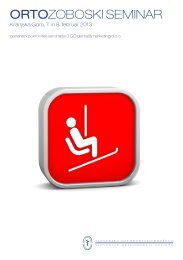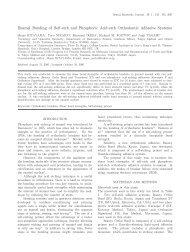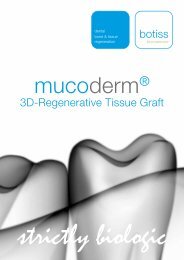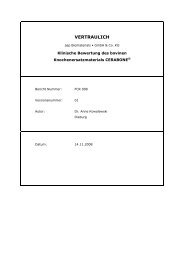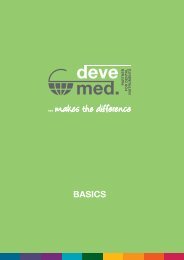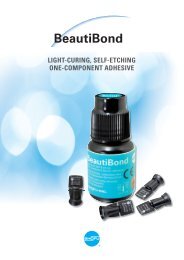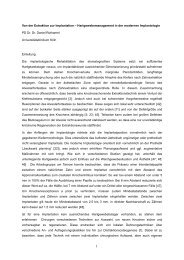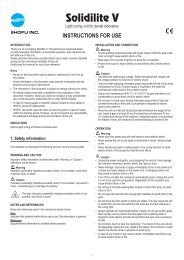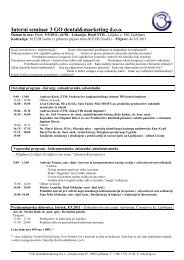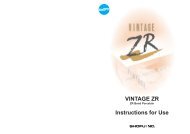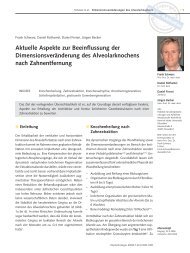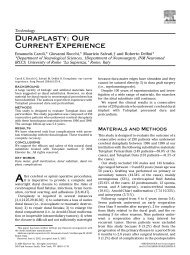Puros White Paper r1.qxd - 3GO
Puros White Paper r1.qxd - 3GO
Puros White Paper r1.qxd - 3GO
Create successful ePaper yourself
Turn your PDF publications into a flip-book with our unique Google optimized e-Paper software.
ACLINICAL CASE SERIES<br />
IN ORAL REHABILITATION<br />
Clinical and Histological Analyses of <strong>Puros</strong> ®<br />
Cancellous Chip Allografts in Humans<br />
INTRODUCTION<br />
Localized human periodontal defects and<br />
generalized ridge atrophy can significantly<br />
compromise esthetics and a patient's<br />
ability to function. While prosthetic rehabilitation<br />
alone can sometimes mitigate these<br />
problems, bone grafting to reconstruct the<br />
hard tissue anatomy will often be necessary<br />
to achieve the desired results. Current treatment<br />
standards also dictate that dental<br />
implants be placed in relation to the anticipated<br />
needs of the prosthetic restoration,<br />
rather than according to the limitations of<br />
available bone. 1 Development of sufficient<br />
bone volume for implant placement can often<br />
only be addressed through bone grafting.<br />
Autogenous bone harvested at the time of<br />
surgery is considered the "gold standard"<br />
of bone graft materials because of its<br />
availability, biological safety and ability to<br />
form new bone through all three known<br />
mechanisms of bone regeneration: osteogenesis,<br />
osteoinduction and osteoconduction. 2-3<br />
Drawbacks to the exclusive use of autogenous<br />
bone include increased operating time,<br />
donor site morbidity, poor quality or quantity<br />
of available bone, limitations in the sizes and<br />
shapes of available grafts, and the potential<br />
for intraoperative and postoperative complications.<br />
4-6<br />
Allogenic bone graft materials have been<br />
widely used as alternatives to autogenous<br />
bone for over four decades, and have<br />
been shown to enhance the rate of bone formation<br />
by serving as a scaffold across the<br />
defect site for the regenerating bone (osteoconduction).<br />
6-9 While alloplastic bone substitutes<br />
have also been shown to effectively fill<br />
periodontal bone defects, 5, 10-14 they reportedly<br />
provide little or no new bone formation and<br />
heal through connective tissue encapsulation<br />
of the graft material.<br />
5, 15<br />
<strong>Puros</strong> (Zimmer Dental Inc., Carlsbad, CA)<br />
is an allogenic, solvent-preserved, human<br />
cancellous bone graft material. Voluntary tissue<br />
donors were selected according to a stringent<br />
protocol that included patient and family<br />
interviews, review of medical, social, and<br />
sexual histories, physical examinations,<br />
autopsy findings (if performed) and laboratory<br />
tests to rule out infectious or malignant<br />
diseases. Tissues were aseptically harvested<br />
24 hours postmortem by a tissue bank certified<br />
by the American Association of Tissue<br />
Banks (AATB), and held in approved storage<br />
until preservation and sterilization processes<br />
were performed.<br />
Additional serological tests were performed<br />
to rule out Hepatitis B/C antigens<br />
and antibodies to HIV I/II. The donor<br />
bone was subjected to the Tutoplast ® Process<br />
(Tutogen Medical, Inc., Neunkirchen,<br />
Germany), which included delipidization,
osmotic treatment, oxidative treatment, solvent<br />
dehydration and sterilization through<br />
limited-dose gamma radiation (17.8 GY). 16-17<br />
Processing removes the fat, cells, antigens<br />
and microbes, but retains the osteoconductive<br />
properties of the material by preserving the<br />
collagen, trabecular pattern and porosity of<br />
the donor bone. This method of processing<br />
has also been shown to inactivate the HIV<br />
virus and the agent responsible for<br />
Creutzfeldt-Jakob disease (CJD). 17-22<br />
This two-part paper reports on the (1) clinical<br />
and (2) histological results of <strong>Puros</strong><br />
allogenic bone graft material used in vivo.<br />
Part 1:<br />
Clinical Use of <strong>Puros</strong> Cancellous Chip Allograft in the<br />
Treatment of Human Periodontal Defects<br />
J. Daulton Keith, Jr., DDS, FICD<br />
Private Practice in Periodontics, Charleston, South Carolina<br />
CASE NO. 1: RESORBED LABIAL PLATE<br />
A52-year-old female non-smoker presented<br />
with a missing right maxillary lateral<br />
incisor and severe atrophy of the labial plate<br />
[Fig. 1]. Clinical evaluation revealed an alveolar<br />
ridge 3 mm in width [Fig. 2]. A monocortical<br />
bone graft was harvested from the<br />
patient’s chin and secured in place with two<br />
lag screws [Fig. 3]. <strong>Puros</strong> bone graft material<br />
was mitered around the autogenous graft<br />
[Fig. 4] and the entire site was covered with<br />
BioMend ® (Zimmer Dental Inc., Carlsbad,<br />
CA), a type-I collagen barrier membrane<br />
[Fig. 5]. After 5 months of healing, adequate<br />
bone fill was achieved and restorative procedures<br />
were commenced [Fig. 6].<br />
1 2<br />
3 4<br />
5 6<br />
Case No. 1 Fig. 1: Preoperative ridge defect; Fig. 2: Periodontal<br />
probe indicates 3 mm of ridge width; Fig. 3: Monocortical chin<br />
graft in place; Fig. 4: <strong>Puros</strong> bone graft in place; Fig. 5: BioMend<br />
membrane covers entire graft site; Fig. 6:Healed bone graft at 5 months.<br />
2
CASE NO. 2: EXTRACTION DEFECTS<br />
A65-year-old female smoker presented<br />
with severe osseous defects in the left<br />
molar region [Fig. 7]. Prior to treatment, the<br />
patient stopped smoking. The non-salvageable<br />
teeth were extracted [Fig. 8] and the<br />
osseous defects were packed with <strong>Puros</strong> allogenic<br />
bone graft material [Fig. 9]. A<br />
BioMend type I collagen barrier membrane<br />
was placed over the graft material [Fig. 10]<br />
and the soft tissues were sutured [Fig. 11].<br />
After 7 months of healing, surgical reentry<br />
revealed significant bone fill [Fig.<br />
12]. There were no visible signs of the<br />
resorbable barrier membrane. Following subsequent<br />
grafting procedures in other locations,<br />
the functional and esthetic needs of the<br />
patient were fully restored.<br />
7 8<br />
9 10<br />
11 12<br />
Case No. 2 Fig. 7: Preoperative osseous defects; Fig. 8: Left<br />
molar extraction sites; Fig. 9: <strong>Puros</strong> graft in place; Fig. 10:<br />
BioMend barrier membrane covers the entire graft site; Fig. 11:<br />
Surgical site sutured; Fig. 12: New bone formation after 7 months<br />
of healing.<br />
13 14<br />
15 16<br />
17 18<br />
Case No. 3 Fig. 13: Preoperative radiograph; Fig. 14: Harvested<br />
bone chips mixed with <strong>Puros</strong>; Fig. 15: Grafts in place; Fig. 16:<br />
Biomend Extend membrane placed over graft; Fig. 17: Radiograph<br />
of graft site; Fig. 18: New bone formation after healing.<br />
CASE NO. 3: PNEUMATIZED SINUS<br />
A62-year-old female presented with<br />
severe alveolar ridge resorption and<br />
pneumatization of the maxillary right sinus<br />
[Fig. 13]. A monocortical bone graft was harvested<br />
from the iliac crest, placed in the right<br />
tuberosity area and secured in place with<br />
screws. Autogenous bone chips were mixed<br />
with <strong>Puros</strong> allogenic bone graft material and<br />
packed into the remainder of the defect [Figs.<br />
14-15]. BioMend Extend TM (Zimmer Dental<br />
Inc., Carlsbad, CA) type I collagen membrane<br />
was placed over the graft [Fig. 16], the<br />
soft tissue flaps were approximated and<br />
sutured [Fig. 17]. After five months of healing,<br />
the BioMend Extend graft material had<br />
completely resorbed and the new bone completely<br />
filled the defect [Fig. 18].<br />
3
Part 2:<br />
Histological Analysis of <strong>Puros</strong> Cancellous Chip Allograft<br />
After 6 Months In Vivo<br />
Ricardo Gapski, DDS, MS, 1 Rodrigo E.F. Neiva, DDS, 2 Tae-Ju Oh, DDS, 3<br />
Hom-Lay Wang, DDS, MSD 4<br />
1 Clinical Assistant Professor, Department of Periodontology, University of Missouri at Kansas City.<br />
2 Clinical Assistant Professor, Department of Periodontics/Prevention/Geriatrics, University of Michigan<br />
School of Dentistry.<br />
3 Clinical Assistant Professor, Department of Periodontics/Prevention/Geriatrics, University of Michigan<br />
School of Dentistry.<br />
4 Professor, Department of Periodontics/Prevention/Geriatrics, University of Michigan School of Dentistry.<br />
HISTOLOGY REPORTS<br />
Abiopsy sample was obtained from a<br />
human grafted tooth extraction socket 6<br />
months after grafting with <strong>Puros</strong> cancellous<br />
chip allograft material. The retrieved specimen<br />
was dehydrated in ascending concentrations<br />
of alcohol, embedded in specialized<br />
resin (Technovit 7200 VLC, Kulzer,<br />
Wehrheim, Germany) and processed to<br />
obtain thin ground sections. Each section was<br />
stained with 1% toluidine blue to improve<br />
contrast for histomorphometric analysis with<br />
backscattered electron image analysis.<br />
Histological examination revealed that<br />
graft turnover (resorption and replacement<br />
by new bone) occurred rapidly with<br />
<strong>Puros</strong> cancellous bone chips. Low-power<br />
photomicrographs showed dense and thick<br />
trabeculae that provided the core with good<br />
integrity [Figs. 19a]. Cancellous bone was<br />
not uniformly distributed throughout the<br />
core, but most of the bone was quite mature,<br />
and graft particles were so well integrated<br />
that it was nearly impossible to differentiate<br />
them from the new bone [Figs. 19b-c]. Highpower<br />
photomicrographs [Figs. 19d] showed<br />
that a lamellar pattern of mature bone had<br />
formed of the surfaces and surrounded the<br />
residual particles of <strong>Puros</strong>.<br />
BIOPSY SPECIMENS FROM AN AUGMENTED HUMAN EXTRACTION SOCKET<br />
Core 20x Occlusal 40x Apical 40x<br />
Occlusal 100x<br />
19a<br />
19b<br />
19c<br />
<strong>Puros</strong><br />
New Bone<br />
Fig. 19a: Entire biopsy core section 20x; Fig. 19b: Occlusal section of core enlarged 40x; Fig. 19c Apical section of<br />
core enlarged 40x; Fig. 19d Occlusal section of core enlarged 100x.<br />
19d<br />
4
DISCUSSION<br />
After grafting, successful bone regeneration<br />
requires a concurrent revascularization<br />
and substitution of the graft material with host<br />
bone without a significant loss of strength. 13<br />
The pattern, rate and quality of new bone substitution<br />
are determined, in part, on complex<br />
reactions between the healing processes of the<br />
biological host and the nature of the graft<br />
material. 21<br />
The Tutoplast Process retains the essential collagen<br />
structure of the <strong>Puros</strong> donor bone.<br />
Collagen is a key component in a wide variety of<br />
human body tissues, including bone, skin, tendons,<br />
cartilage and blood vessels. There are 21 known<br />
collagens, and each serves a specific role. It comprises<br />
approximately 90-95% of the organic component<br />
of bone, 22-23 and is a fundamental building<br />
block in the process of new bone formation.<br />
The cases presented in this paper are clinically<br />
important because the demonstrate the efficacy<br />
of <strong>Puros</strong> allograft material in generating effective<br />
new bone fill.<br />
REFERENCES<br />
1. Keith JD Jr. Localized ridge augmentation with a<br />
block allograft followed by secondary implant<br />
placement: A case report. Int J Periodont Rest<br />
Dent 2004;24:11-17.<br />
2. Albee FH. Fundamentals in bone transplantation.<br />
Experiences in three thousand bone graft operations.<br />
JAMA 1923;81:1429-1432.<br />
3. Tadic D, Epple M. A thorough physicochemical<br />
characterisation of 14 calcium phosphate-based<br />
bone substitution materials in comparison to natural<br />
bone. Biomater 2004;25:987-994.<br />
4. Chesmel KD, Branger J, Wertheim H,<br />
Scarborough N. Healing response to various<br />
forms of human demineralized bone matrix in<br />
athymic rat cranial defects. J Oral Maxillofac<br />
Surg 1998;56:857-863.<br />
5. Francis JR, Brunsvold MA, Prewett AB,<br />
Mellonig JT. Clinical evaluation of an allogenic<br />
bone matrix in the treatment of periodontal<br />
osseous defects. J Periodontol 1995;66:1074-<br />
1079.<br />
6. Hämmerle CHF. The effect of a deproteinized<br />
bovine bone mineral on bone regeneration around<br />
titanium dental implants. Clinical Oral Implants<br />
Research 1998;9:151-162.<br />
7. Burchardt H. The biology of bone graft repair.<br />
Clinical Orthopaedics and Related Research<br />
1983;174:28-42.<br />
8. Reddi AH, Weintroub S, Muthukumaran N.<br />
Biologic principles of bone induction. orthopedic<br />
Clinics of North America 1987;207-212.<br />
9. Urist MR. Bone: Formation by autoinduction.<br />
Science 1965;150:893-899.<br />
10. Kenney EB, Lekovic V, Sa Ferreira JC, Han T,<br />
Dimitrijevic B, Carranz FA Jr. Bone formation<br />
within porous hydroxylpatite implants in human<br />
periodontal defects. J Periodontol 1986;57:76-83.<br />
11. Carranza FA Jr, Kenney EB, Lekovic V,<br />
Talamante E, Valencia J, Dimitrijevic B.<br />
Histologic study of healing of human periodontal<br />
defects after placement of porous hydroxylapatite<br />
implants. J Peiodontol 1987;58:682-688.<br />
12. Lekovic V, Kenney EB, Kovacevic K, Carranza<br />
FA Jr. Evaluation of guided tissue regeneration in<br />
Class II furcation defects. A clinical re-entry<br />
study. J Periodontol 1989;60:694-698.<br />
13. Barnett JD, Mellonig JT, Gray JL, Towle HG.<br />
Comparison of freeze-dried bone allograft and<br />
porous hydroxylapatite in human periodontal<br />
defects. J Periodontol 1989;60:231-237.<br />
14. Bowen JA, Mellonig JT, Gray JL, Towle HJ.<br />
Comparison of decalcified freeze-dried bone allograft<br />
and porous hydroxylapatite in human periodontal<br />
osseous defects. J Periodontol<br />
1989;60:647-654.<br />
15. Baldock WT, Hutchens LH, McFall WT Jr,<br />
Simpson DM. An evaluation of tricalcium phosphate<br />
implants in human periodontal osseous<br />
defects in two patients. J Periodontol 1985;56:1-<br />
7.<br />
5
16. Feuille F, Knapp CI, Brunsvold MA, Mellonig<br />
JT. Clinical and histologic evaluation of bone<br />
replacemnt grafts in the treatment of localized<br />
alveolar ridge defects. Part 1: Mineralized<br />
freeze-dried bone allograft. Int J Periodontics<br />
Resotrative Dent 2003 Feb;23:29-35.<br />
17. Günther KP, Scharf H-P, Pesch H-J, Puhl W.<br />
Osteointegration of solvent-preserved bone transplants<br />
in an animal model. Osteologie<br />
1995;5(1):4-12.<br />
18. Bellanger-Kawahara C, Cleaver JE, Diener TO,<br />
Prusiner SB. Purified scrapie ions resists inactivation<br />
by UV irradiation. J Virol 1987;61:159-<br />
166.<br />
19. McKinley MP, Masiarz FR, Isaacs ST, Hearst JE,<br />
Prusiner SB. Resistance of the scrapie agent to<br />
inactivation by psoralens. Photchem Photobiol<br />
1983;37:539-545.<br />
21. Brown P, Wolff A, Gajdusek DC. A simple and<br />
effective method for inactivating virus infectivity<br />
in formalin-fixed samples from patients with<br />
Creutzfeldt-Jakob disease. Neurology<br />
1990;40:887-890.<br />
22. Prusiner SB, Groth DF, McKinley MP, Cochran<br />
SP, Bowman KA, Kaspar KC. Thiocyanate and<br />
hydroxyl ions inactivate the scrapie agent. Proc<br />
Natl Acad Sci USA 1981;78:4606-4610.<br />
21. Stevenson S, Davy DT, Klein L, Goldberg VM.<br />
Critical biological determinants of incorporation<br />
on non-vascularized cortical bone grafts. J Bont<br />
Joint Surg 1997;79-A(1):1-16.<br />
22. Carter DR, Spengler DM. Mechanical properties<br />
and composition of cortical bone. Clin Orthop<br />
Rel Res 1978;135:192-217.<br />
23. Geesink RGT. Hydroxyl-apatite coated hip<br />
implants. Maastricht, The Netherlands:<br />
Osteonics, 1988: 17-23.<br />
20. Prusiner SB. Novel proteinacaceous infectious<br />
particles cause scrapie. Science 1982;216:136-<br />
144.<br />
Zimmer Dental Inc., 1900 Aston Avenue, Carlsbad, CA 92008-7308<br />
P: 760.929.4300 F: 760.431.7811<br />
www.zimmerdental.com<br />
Tracking No. 6787<br />
4/4/04<br />
6



